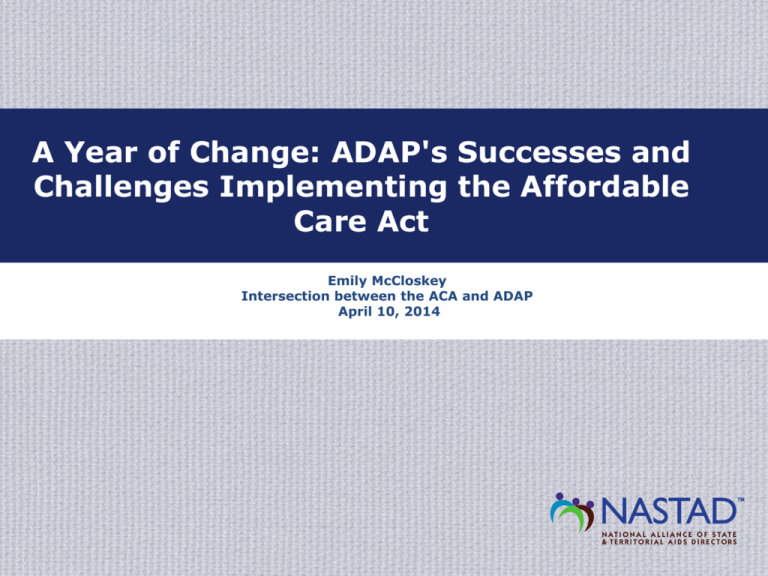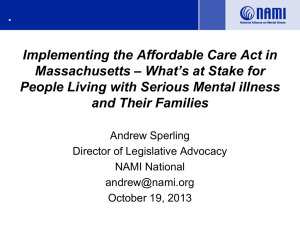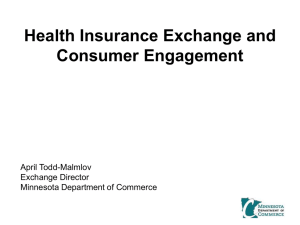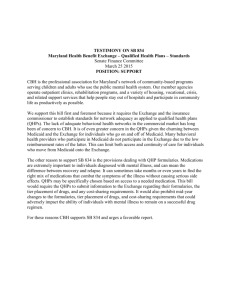presentation by Emily McCloskey
advertisement

A Year of Change: ADAP's Successes and Challenges Implementing the Affordable Care Act Emily McCloskey Intersection between the ACA and ADAP April 10, 2014 Who is NASTAD? NASTAD is a non-profit national association of state health department HIV/AIDS program directors who administer HIV/AIDS and viral hepatitis prevention, care and treatment programs funded by state and federal governments. – Domestic Programs Health Care Access, Health Equity, Prevention, Viral Hepatitis – Policy and Legislative Affairs – Global Program Mission NASTAD strengthens state and territory-based leadership, expertise and advocacy and brings them to bear on reducing the incidence of HIV and viral hepatitis infections and on providing care and support to all who live with HIV/AIDS and viral hepatitis. Vision NASTAD’s vision is a world free of HIV/AIDS and viral hepatitis. Presentation Overview Current State of ADAPs ADAPs in a Reformed Health System Enrollment into Coverage Insurance Assistance and Premiums Leveraging the ACA to Raise the Bars Questions and Answers Current State of ADAPs The National ADAP Budget, by source, FY1996-FY2013 ADAP Client Utilization ADAP Client Demographics ADAP Clients Served, by Race/Ethnicity, June 2013 American Indian/Alaskan Native <1% ADAP Clients Served, by Gender, June 2013 Multi-Racial 1% Native Hawaiian/Pacific Islander <1% Other 1% Transgender <1% Unknown <1% Unknown 2% Asian 2% Female 21% Hispanic 27% Non-Hispanic Black/African American 34% Male 78% Non-Hispanic White 33% ADAP Client Demographics (continued) ADAP Clients Served, by Income Level, June 2013 ADAP Clients Served, by Age, June 2013 >64 Years 4% Unknown <1% <12 Years <1% 13-24 Years 4% >400% FPL 1% 301-400% FPL 4% 45-64 Years 50% 25-44 Years 41% Unknown 13% ≤100% FPL 43% 201-300% FPL 13% 139-200% FPL 15% 101-138% FPL 10% ADAP Insurance Coordination Clients Served and Estimated Expenditures in Insurance Purchasing and Continuation, 2013 52,568 60,000 $400 50,000 46,653 $397 41,095 $280 40,000 $240 34,341 $268 30,621 30,000 $227 $200 $194 $160 20,960 20,000 12,311 10,000 5,272 - $19 2002 7,167 $38 2003 2004 $120 $159 $107 7,277 $30 15,843 13,744 $320 $80 $75 $75 $84 2005 2006 $40 $2007 2008 2009 2010 2011 2012 2013 Estimated Fiscal Year Expenditures (in millions) Number of Clients (June) $360 FY2014 Final Funding The Bipartisan Budget Act of 2013 increased non-defense discretionary funding by $22 billion Final numbers for FY2014 included a $14 million increase for ADAP FY2015 Budget Outlook Caps for FY2015 are slightly larger than FY2014 President Obama’s budget released on March 4 ADAP and Part B were flat-funded Congress is beginning work on the appropriations process ADAPs in a Reformed Health System ACA: Three Prongs Public insurance reforms • • • Private insurance reforms • • Health infrastructure reforms Medicaid expansion Medicare Part D reforms Marketplaces/exchan ges Prohibitions on discriminatory insurance practices Investments in community health centers, health workforce, coordinated care, and prevention Recap of 2014 Open Enrollment: Top Four Challenges and Solutions Challenges Solutions Healthcare.gov has experienced significant glitches Programs worked directly with plans to enroll clients; urging case managers to build in extra time to assist clients Limited coordination between Programs sent clients directly to Medicaid Marketplaces and Medicaid In certain states, participation in ACA enrollment by state employees is limited or prohibited Programs worked with community organizations and coalitions to coordinate client education, outreach, and enrollment efforts Qualified Health Plan (QHP) information has been incomplete or unavailable Programs have had some success reaching out directly to plans for information ADAP in a Reformed Health System What will ADAP “look like” after January 1, 2014? – Traditional ADAP Full payment of medications for those not eligible for coverage under the Affordable Care Act – Insurance purchasing/continuation Wrap-around of Medicaid and Medicare – Including Medicaid expansion and non-expansion states Insurance purchasing – purchasing of a new policy – Including policies purchased through the Exchange Insurance continuation – payment for an existing policy – Including policies purchased through the Exchange Enrollment into Coverage Case Study: Ryan White Program Clients 2014 ACA Coverage Option Income Eligibility Threshold ADAP Clients Served, by Income Level (June 2012) 301-400% FPL 6% 201-300% FPL 15% >400% FPL 2% Unknown <1% 139-200% FPL 19% 101-138% FPL 14% ≤100% FPL 45% NASTAD Annual ADAP Monitoring Report, January 2013 Medicaid Expansion Income up to 138% FPL Advance Premium Tax Credit for purchase of private insurance through exchanges/marketplaces Income between 100 and 400% FPL (ineligible for Medicaid or affordable employer-based coverage) Cost-sharing subsidies to offset out-of-pocket costs of private insurance through exchanges/marketplaces Income between 100 and 250% FPL (ineligible for Medicaid or affordable employer-based coverage) Unsubsidized private insurance coverage through exchanges/marketplaces Income below 100% FPL (ineligible for Medicaid) Mapping Client Transitions Uninsured • Lawfully present • Income up to 138% FPL Medicaid Uninsured • Lawfully present • Income 138 - 400% FPL Subsidized private insurance through Marketplace Currently on Medicaid No transition (except for waiver beneficiaries) Currently on other government-sponsored insurance (e.g., Medicare, TRICARE) No transition Currently on or have access to employerbased coverage If plan is affordable and comprehensive, no transition Currently on PCIP or high risk pool Medicaid or Marketplace coverage Uninsured and categorically ineligible for federal programs No transition 16,000+ ACA-related Transitions Facilitated by State HIV Programs VT WA WA ME ND MT NY MN OR WI SD ID MI WY NV CO AZ KS OK NM IN DE WV KY MO VA NC TN AR SC GA MS AL AK TX LA FL HI Medicaid 10,282 QHPs 6,647 NJ OH IA IL CA CT PA NE UT NH MD DC Enrollment into Coverage: Key Dates Qualified Health Plans • Enrollment Deadline for a Plan Effective Date of April 1st MARCH 15th • Enrollment Deadline for a Plan Effective Date of May 1st Deadline to switch plans 31st • Medicaid 31st April PCIPs • PCIP coverage ends CONTINUOUS ENROLLMENT 2015 QHP Open Enrollment Period November 15, 2014 to February 15, 2015 Next open enrollment period pushed back 30th Enrollment into Coverage: Where States stand on Medicaid VT WA MT ME ND NH* MN OR WI* SD ID WY NV PA* IL UT CO CA MI* IA* NE IN* OH WV KS MO KY OK NM TX AK AL DC SC AR* MS VA CT RI NJ DE MD NC TN AZ MA NY GA LA FL HI Implementing Expansion in 2014 (27 States including DC) Open Debate (5 States) Not Moving Forward at this Time (19 States) Source: Kaiser Family Foundation Enrollment into Coverage: Medicaid Expansion Options Traditional Medicaid State decides to expand Medicaid to people with income up to 138% FPL (Yay!) How to structure the expansion?? Alternative Benefits Plan that could be different from traditional Medicaid Premium assistance program to purchase Qualified Health Plans (QHPs) for Medicaid beneficiaries Weighing the Pros and Cons of Premium Assistance Plans The Good Politically feasible way to get state to expand Medicaid Reduces churn between Medicaid and QHPs May allow access to bigger provider networks The Concerns May weaken Medicaid oversight and protections States are using 1115 waivers to ask for even more flexibility from Medicaid rules Private insurance is more expensive than traditional Medicaid, so may be difficult to show that costs are “comparable” Enrollment into Coverage: Mapping ACA Coverage Transitions Medicaid Uninsured • Lawfully present • Income 100 - 400% FPL Subsidized private insurance through Marketplace Uninsured and in non-Medicaid expansion state • Lawfully present • Income below 100% FPL Unsubsidized private insurance through Marketplace Currently on Medicaid No transition Currently on other governmentsponsored insurance (e.g., Medicare, TRICARE) No transition Currently on or have access to employer-based coverage If plan is affordable and comprehensive, no transition Currently on PCIP or high risk pool Medicaid or Marketplace coverage Uninsured & categorically ineligible for federal programs No transition Churning Uninsured • Lawfully present • Income up to 138% FPL Grantees are defining how to“vigorously pursue” client eligibility for Medicaid and QHP coverage Income fluctuations Enrollment into Coverage: Addressing Churn Subsidies to Purchase QHP (income between 139 and 400% FPL) Medicaid (income up to 138% FPL) Considerations to mitigate churn: Eligibility for premium tax credits and cost-sharing is based on ANNUAL income If a person switches from a QHP to Medicaid and back to a QHP, he/she will get credit for any cost-sharing charges paid before moving to Medicaid – BUT only if the the person re-enrolls in the same Marketplace plan from same insurer – This rule also applies any time someone re-enrolls in the same Marketplace plan they had during the same year. State Medicaid policies (e.g., 12 month eligibility) Enrollment into Coverage: The ACA and Immigrants Lawfully Present Medicaid • >5 years in the country-Eligible • >5 years in country – Eligible for PTC o Lawfully present immigrants are (100-400% of FPL) and Cost sharing banned from Medicaid eligibility subsidy (100-250% Special Consideration for of FPL) for five years • <5 years in country- Eligible for PTC Mixed Status Families (0-400% of FPL) and Cost-sharing subsidy (0-250% of FPL) • Eligibility coverage INDIVUAL MANDATE APPLIESfor (with exceptions as applicable) • Not Lawfully Present Qualified Health Plans options and any applicable Ineligible • Ineligible for subsidies subsidies are available for o Eligible for Ryan White o Some State HIV Programs have the lawfully present had success enrolling undocumented immigrants for members of the household unsubsidized QHPs outside of the Marketplace INDIVUAL MANDATE DOES NOT APPLY Enrollment into Coverage: Special Enrollment Periods Trigger Event for Special Enrollment Period Coverage Effective Date Loss of minimum essential coverage (NOT due to failure to pay premiums on time) First day of month following plan selection Gain of dependent through birth or adoption Day of birth, placement Gain of an dependent through marriage First day of month following plan selection Change in immigration status to citizen, national, or lawfully present Regular coverage effective dates Unintentional, inadvertent, or erroneous enrollments Regular coverage effective dates Substantial violation of contract by insurance company Regular coverage effective dates Enrollee is newly eligible or newly ineligible for advance payments of the premium tax credit or has a change in eligibility for cost-sharing reductions Regular coverage effective dates Permanent moves that create access to new QHPs Regular coverage effective dates Certain American Indians may enroll in QHPs one time per month Regular coverage effective dates Exceptional circumstances Regular coverage effective dates Enrollment into Coverage: Individual Mandate Exemptions Exemption How to Apply Below tax filing threshold (about $10,000 for an individual in 2013) No need to apply; exemption is automatic Hardship exemption (includes homelessness, natural disaster, and situation where person would have been eligible for Medicaid state had expanded) Marketplace application OR federal tax return • Note: to be found eligible for the nonMedicaid expansion state exemption, a person must receive a Medicaid denial. Unaffordable coverage (defined as over 8% of household income) Marketplace application • Note: a person eligible for an exemption because coverage is unaffordable based on expected income may qualify to buy catastrophic coverage through the Marketplace. Short coverage gaps (a gap that last less than three months) Federal tax return Indian Tribes Marketplace application OR federal tax return Insular areas and territories No need to apply; exemption is automatic Enrollment into Coverage: Enforcement of the Individual Mandate SelfAttestation Marketplace s Employers IRS Medicare Medicaid (including Advantage plans) (including SCHIP) Enrollment into Coverage: Considerations for State HIV Programs • Medicaid Outreach and Enrollment Activities o Document vigorous pursuit of coverage options • Maintain awareness of client insurance status and special eligibility opportunities o Manage client churn o Advise special clients of special enrollment periods Maintain awareness special and standard coverage effective dates • Ensure O&E staff understand coverage options for immigrants Insurance Assistance and Premiums Insurance Assistance and Premiums: : Top Four Challenges and Solutions Challenges Solutions Issuers in several jurisdictions refuse to accept third-party premium payments from Ryan White/ADAP Multi-pronged state and federal advocacy Difficult coordination/communication Develop relationship with QHP with QHPs for timely submission of contacts as well as Marketplace premium payments Cost-effectiveness models have MANY Utilize NASTAD model; peer models variables for assessing cost Medical co-pays continue to be barrier to access to affordable care Work across Ryan White Parts to identify and fill affordability gaps Insurance Assistance and Premiums: Ongoing Challenges Insurance Company Health Department Data Sharing Provider Insurance Assistance and Premiums: Health Insurance Literacy Insurance Assistance and Premiums: Augmenting Benefits Across Insurance Programs Types of Insurance ADAP/Part B Assists Clients to Purchase Types of Costs ADAP/Part B Covers Employer-based coverage Premiums COBRA Prescription co-pays and co-insurance PCIP Prescription deductibles State high risk pools Medical co-pays and co-insurance Individual plans Medical deductibles Medicare Part D Medicaid Insurance Assistance and Premiums: Prescription Drug Formulary EHB Standard = same number of drugs per U.S. Pharmacopeia (USP) category/class as state’s benchmark plan USP Category USP Class Anti-viral NRTIs NNRTIs Protease inhibitors Anti-Cytomegalovirus (CMV) agents Anti-hepatitis agents Other Missing from USP classification system = combination therapies Insurance Assistance and Premiums: Assessing Provider Networks HIV/Ryan White Providers • Must include “Essential Community Providers,” but plans still vary on coverage Pharmacy Network • Are ADAP pharmacies (or pharmacies who will coordinate with ADAP) included? • Do network pharmacies require mail order? Insurance Assistance and Premiums: Tax Credits and Cost-Sharing Reductions Premium Tax Credits (available to people with income between 100 and 400% FPL) Cost-Sharing Reductions (available to people with income between 100 and 250% FPL) APPLICATION Person applies for premium tax credit and cost-sharing reductions during exchange open enrollment periods with either most recent tax returns or other documentation of income (e.g., pay stubs). PAYMENT Premium tax credit is paid in advance on a monthly basis directly to the health plan. Payment amounts are based on income. ADAP may cover amount not covered by federal subsidy. PAYMENT Cost sharing reductions mean that plans pay a greater amount of the covered costs, taking that burden off of the enrollee. The costsharing subsidies are paid directly to the plan. ADAP may cover amount not covered by federal subsidy. RECONCILIATION When the person files a tax return for the actual year in which he/she received the tax credit, underpayments or overpayments are reconciled (overpayments are capped based on income). Insurance Assistance and Premiums: Tax Credits and Cost-Sharing Reductions 2013 Consumer earns income and generates a modified adjusted gross income (MAGI) for the 2013 tax year 2014 Consumer receives advance premium tax credit and cost sharing reductions based on 2013 MAGI 2015 Consumer files 2014 tax return and reconciles 2013 MAGI with 2014 MAGI – under/overpayment assessed by IRS Leveraging the ACA to Raise the Bars Leveraging the ACA to Raise the Bars: Translating Coverage into Care and Treatment SERVICE QHP MEDICAID RW/ ADAP/CDC HIV Testing Continue to cover in certain settings RX Cost-sharing assistance MEDICAL CASE MANAGEMENT ORAL HEALTH LABS Cost-sharing assistance MENTAL HEALTH SERVICES Cost-sharing assistance SUBSTANCE ABUSE TREATMENT Cost-sharing assistance HIV PRIMARY CARE Cost-sharing assistance MEDICAL TRANSPORTATION INPATIENT HOSPITAL SERVICES Adapted from West Virginia Ryan White Part B Program Limited Coverage Preparing Providers for Health Reform Relationship w/safety net providers Strategic planning to negotiate new health care landscape Local preparation for health reform Preparation to provide vital enabling services not covered by ACA insurance expansion Preparation for insured clients (e.g., billing) Leveraging the ACA to Raise the Bars: Translating Coverage into Care and Treatment 90% 82% 80% 66% 70% 60% 0% Virally Suppressed 10% 33% Prescribed ART 20% 37% Retained 30% Diagnosed 40% Linked to Care 50% 25% ACA Outreach and Enrollment Programs and Resources HIV/AIDS Programs and Providers Insurance Assisters Patient Navigator Program Certified Application Counselors Consumer outreach and enrollment Community Health Centers Enroll America Breaking Down Program and Service Silos: Coordinated Care Opportunities through the ACA Coordinated Care Opportunities Contracting arrangements Medicaid Health Homes - - Targets populations with chronic conditions, including HIV Between support services providers and medical providers Capitated payments - Starting to include support services Patient Centered Medical Homes Quality and access measures - - Certification emphasizes whole-person care and role of vital enabling services in improving health outcomes - Include HIV quality measures Emphasize care coordination Resources National Alliance of State & Territorial AIDS Directors (NASTAD), www.NASTAD.org – Amy Killelea, akillelea@nastad.org – Xavior Robinson, xrobinson@nastad.org HIV Health Reform, http://www.hivhealthreform.org/ Treatment Access Expansion Project, www.taepusa.org HIV Medicine Association, www.hivma.org Health Care Reform Resources – State Refo(ru)m, www.statereforum.org – Kaiser Family Foundation, www.kff.org – Healthcare.gov, www.healthcare.gov Questions and Answers Contact Information Emily McCloskey Manager, Policy and Legislative Affairs NASTAD Phone: (202) 434.8090 emccloskey@NASTAD.org www.NASTAD.org




